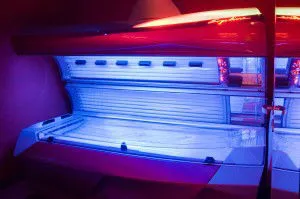There is a myth that tanning beds are actually safer than exposure to the sun, but studies, including recent research from the University of Dundee, Scotland, have shown that the risk of skin cancer from tanning beds is twice that of spending the same length of time in the Mediterranean midday summer sun.
Just last month, the FDA passed regulations requiring stronger warnings about the dangers of tanning beds. Makers of sun lamps and related devices now must include a black box warning that states the beds should not be used by those who are under the age of 18, and manufacturers must provide more warnings about the risk of cancer in pamphlets, catalogues and websites promoting the products.
They are required to warn that the devices shouldn’t be used by anyone who has a family history of skin cancer, or who has had skin cancer. Twenty four states currently have laws banning minors from using indoor tanning equipment.
Malignant melanoma is the most threatening type of skin cancer, with previous studies confirming a link between the use of tanning beds and a greater risk of four types of skin cancers, including basal cell carcinoma, squamous cell carcinoma and melanoma.
Tanning beds are not safe, despite the claims by tanning salons that are out to make a profit. Teens are at even greater risk as their bodies are undergoing accelerated growth rates, which means their cells are even more prone to harmful damage by UV radiation. Routinely tanning the skin at a young age puts teens at a significantly higher lifetime risk of developing skin cancer.
On the other hand, the sun is a giver of life – we need the sun’s rays in order to live, but at the same time being out in the sun without protection and getting burned or deeply tanned is not a good idea either.

The sun offers many great benefits, though you probably hear much more about its dangers. The key is that a little goes a long way. Here at The Alternative Daily, we’ve previously discussed the important rules when it comes to sun exposure. By following these tips, you’ll get a healthy dose to ensure appropriate vitamin D levels without increasing your risk of skin cancer.
- Avoid the sun between about noon and 3 pm, as this is when the sun’s rays can cause the most damage.
- If you have to be in the sun for longer periods of time, wear a hat as well as lightweight, white clothing if possible, and use only non-toxic sunscreens.
- Don’t “tan” through a window, as you’ll get all UVA rays and none of the beneficial UVB rays.
- When it comes to optimal health – ‘real’ sunlight is almost always better.
-The Alternative Daily
Sources:
https://www.thealternativedaily.com/1-worst-sunscreen-avoid-costs
http://www.medicalnewstoday.com/articles/255082.php
http://abcnews.go.com/Health/wireStory/govt-puts-age-restriction-tanning-beds-23913806
